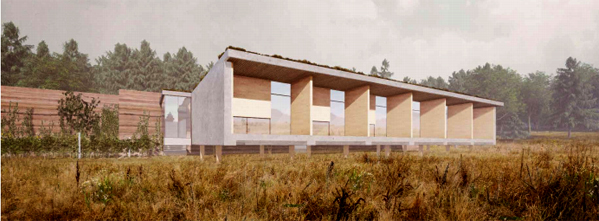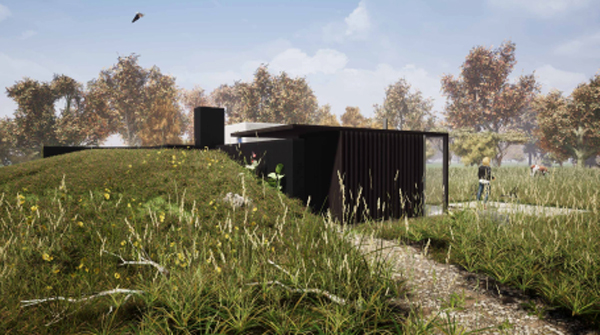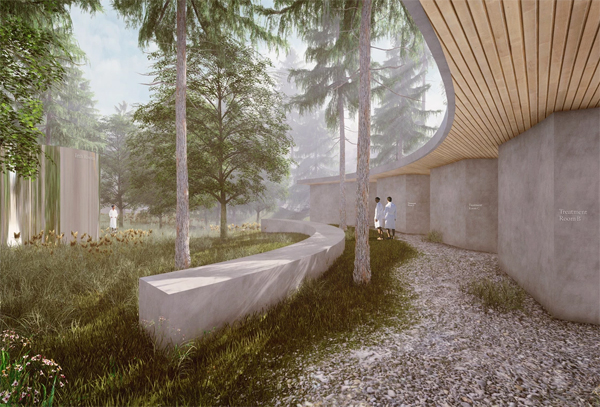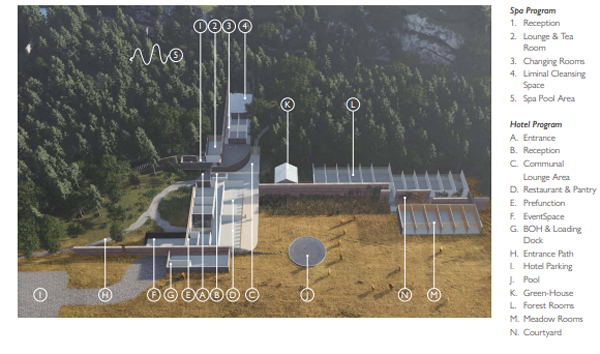IRTH Hotel and Spa shares vision of County eco-resort via virtual meeting
Administrator | Jun 16, 2020 | Comments 26

By Sharon Harrison
Participants in a virtual meeting learned about plans for the IRTH Landscape Hotel and Spa – a 30-room ‘eco-retreat’ connecting its guests to the healing power of nature.
Plans were shared during an online community consultation session held late last month for the a proposed project on County Road 8 in North Marysburgh.
IRTH is in the process of submitting an official plan amendment and zoning bylaw amendment, where part of the submission process involves holding an in-person consultation meeting with the community on the proposal.
With public meetings still not permitted due to the COVID-19 outbreak, the session, at the recommendation of the County’s planning department, was held via Zoom where the public was invited to participate.
Specifically, the IRTH team shared information on the refinements to their finalized concept together with a breakdown of reports, before addressing submitted questions and comments from the public.

IRTH founder Melanie Hazell
Attendees at the virtual meeting from the IRTH team included Melanie Hazell (IRTH Landscape Hotel and Spa founder), Alex Daprato (IRTH Landscape Hotel and Spa partner), Jonathan Kearns (IRTH Architect and CEO, Kearns Mancini Architects) and Marko Cekic (Land Use Planner, McIntosh Perry), as well as Brian Daly and Scott Ferguson. Scott Reynolds (Senior Environmental Planner, Ainley Graham & Associates Limited) was unable to attend due to a death in the family. Hazell said a further Zoom call would be arranged at a later date where Reynolds would deliver his environmental report.
The proposed development is on land bounding County Road 8 and Rock Crossroad in the far eastern part of Prince Edward County on an 89-acre parcel of land consisting of limestone escarpment, mixed forest, meadow and marshland.
The four-season resort says it will create 20-30 full-time jobs, as well as indirect opportunities for suppliers and local businesses. The development, if approved, plans to open summer 2023.
“We are here to provide information about our proposal to create an eco-resort in North Marysburgh consisting of 18 hotel rooms, 12 cabins, a spa, a restaurant and a conference space,” said Melanie Hazell, founder of IRTH Landscape Hotel and Spa.
Hazell noted that the public was invited to submit questions in advance of the meeting and said around 30 questions had been received. The public also had the option of submitting questions in real time during the meeting.
“Following our last meeting, based on your concerns and questions, we have reduced the size of the project and evolved our concept with an even greater focus on land restoration, sustainability, with a net goal of being net-positive,” said Hazell.

IRTH cabin
“We are proposing a small boutique hotel and spa which has a gross floor area of approximately 20,811 square feet, which translates into about 0.5 per cent of the overall 89-acre site,” said IRTH architect, Jonathan Kearns, noting a very low-density development.
The average daily population of the site is planned to be about 100-130, which represents a ratio of about 1.3 people per acre.
Car parking in small wooded lots will be provided for about 100 cars.
“The parking is stretched out into several sections so that it’s very unobtrusive,” added Kearns.

IRTH spa
“The architecture of the IRTH Landscape Hotel and Spa works with nature as it is found and draws out its undiscovered treasures.”
The main lodge consists of 18 hotel rooms, a small conference centre and restaurant, administration and spa.
“We are positioning the main lodge to be at the intersecting line between forest and meadow. All buildings are single storey. Cabins have been designed for privacy and tranquility, where each cabin site is keyed into a unique facet in the landscape.”
IRTH propose the use of local materials, including stone, wood, rammed earth and concrete.
“We are choosing low-energy embodied materials for net-zero carbon. These materials are being used to build the capital buildings, so the initial construction being close to net-zero carbon as we can get,” Kearns said.
“In the operating of the facilities, we are designing the buildings to the international classified standard, and will achieve a net-positive energy status and net-zero carbon,” he said. “During the construction phase, as much as possible will be built off-site using modular components to minimize the intrusive of construction into the landscape.”
 “The cabins and landscape will be accessed by pedestrian trails and raised boardwalks, so the only vehicular movement beyond the parking lot will be by small electric service vehicles,” explained Kearns. “The spa itself will be a nature-intensive aesthetic experience allowing people to connect with the texture and sounds of the forest and the limestone cliffs of the escarpment.”
“The cabins and landscape will be accessed by pedestrian trails and raised boardwalks, so the only vehicular movement beyond the parking lot will be by small electric service vehicles,” explained Kearns. “The spa itself will be a nature-intensive aesthetic experience allowing people to connect with the texture and sounds of the forest and the limestone cliffs of the escarpment.”
Alex Daprato, partner with IRTH Landscape Hotel and Spa, touched on what they plan to do with the land itself.
He noted about a quarter of the 89 acres of the property is covered in invasive species, including wild parsnip, giant hogweed, dog strangling vine and buckthorn.
“When you get these invasive species on your property, it affects the land in a way where these species bully out and compete with the natives that live in that area and have evolved with that local eco-system over thousands of years,” said Daprato. “You start to see a dip in insect life as they were part of the vegetation and you get a biodiversity loss all the way up the food line.”
He said their goal has been to slowly work and correct that.
The front fields would contain native grasses, wildflowers, fruits and vegetables, encouraging a wide range of insects, birds, small rodents and wildlife to return. The back field will be planted with native new-growth forest.
“In short, returning the land to a place of natural, native and diversity that would have existed before colonization,” said Daprato. “We will return what we took from the land with our seeding and native forest re-growth program.”
The lands subject to the IRTH Landscape Hotel and Spa are legally described as part of Lot A, Concession lakeside east of Cape Vesey, township of North Marysburgh, municipality of the County of Prince Edward, known as the ‘subject lands’, explained Marko Cekic, Land Use Planner with McIntosh Perry.

The subject lands are bound by residential, commercial and agricultural, which are vineyards, and vacant land uses. It is approximately 32 hectares in area, with roughly 475.73 metres of frontage on County Road 8.
The subject lands are located along County Road 8, northwest of the intersection of County Road 8 and Rock Crossroad and approximately six kilometres east of Waupoos.
The site is currently undeveloped and largely consists of a mix of former agricultural fields and forest lands, also a marsh associated with the Lost Lake swamp and a small water course flowing east out of the Lost Lake swamp are located on site, said Cekic.
The subject lands are also characterized by an escarpment on the southern end of the property and the Lost Lake basin escarpment.
The subject lands according to the Official Plan are designated rural and environmental protection.
“The proposed use is not explicitly permitted within the rural designation, so an Official Plan amendment is therefore required to permit the development, and includes the proposed tourist/commercial use,” explained Cekic. “The proposed tourist commercial development will bring a unique and innovative year-round business into the County that will increase non-residential tax base taxable assessment and generate local employment opportunities.”
He said, “The zoned Rural 2 and Rural 3 (RU2 and RU3) and EP (Environment Protected) zone has been applied to the area of natural and scientific interest, so an ANSI, the Lost Lake basin and escarpment forest located in the very north portion of the site, the Lost Lake swamp and escarpment running in a north-south direction in the southern portion of the property.”
To implement the Official Plan amendment, Cekic said a concurrent zoning bylaw application is being filed to re-zone portions of the subject lands currently zoned RU2 and RU3 to a special tourist/commercial zone.
He noted extensive public engagement consultation on the project has taken place.
In 2017 and 2018, there were direct neighbour introductions and an explanation of the intent of the proposal. A meet and greet in October 2018, first public information session in November 2018, and in April 2019 they continued email correspondence to neighbours and community members. In May 2020, the IRTH website was launched to provide an overview of the development.
A question and answer session followed the meeting, facilitated by Scott Ferguson who noted more than three dozen questions had been submitted.
He said four topics were addressed: environmental, planning/zoning, architectural site, and business operations, with more than two-thirds of the questions centred on business operations, and only three questions about environmental issues.
In the planning/zoning category, one question addressed vehicle access to the site, including maintenance and servicing vehicles.
Cekic noted that a legal easement will be required over 501 Rock Crossroad which would run with the title of the property (it is currently under the same ownership, so owned by the IRTH team).
Concerns over the additional traffic and its impact on the already fragile infrastructure were also addressed.
Another question related to septic and grey water and asked if there was sufficient water from the aquifers so as not to impact neighbours’ supply of water (Cekic confirmed there was). The question of whether grey water was processed on the property was raised. Cekic said some grey water will be conserved, but none is expected to leach outside the property.
The issue of light pollution came up with the question, ‘How will you commit to preserving the dark sky environment crucial to the natural habitat?’
“Preserving the night sky is one of our objectives,” answered Kearns.
Under the business operations category, it was asked about plans for the snowmobile and ATV trail.
“Having snowmobile and ATV traffic is not compatible with the site plan and land restoration and the nature immersion we are creating for guests,” said Hazell.
She noted there was an existing agreement with the previous owner that allowed snowmobiles to use the property, although ATVs were not formally part of the agreement, but used it anyway.
When asked if locals can use the property, Hazell said, “Locals will be welcome to enjoy guided forest therapy walks.”
Another question asked what the purpose of the entrance at Rock Crossroad was. Hazell said it was for access to the cabins as well as her proposed new home.
She noted that staff accommodations have been removed from the initial plan and confirmed there will be no staff accommodations at this point.
“The only thing on the site at Rock Crossroad will be my eventual home,” said Hazell.
Waste management and garbage were also addressed in a question.
“Zero plastics, no plastics on site, reducing waste as much as possible, working on a philosophy of cradle to cradle, so whatever we use going through a cycle of re-use,” answered Daprato.
“There is already significant tree removal by your team on the landscape, and the width of the entrances is substantial. How does this meld with the IRTH philosophy of being land caretakers?” came another question.
Daprato explained the trees needed to be cleared for testing to be take place.
“We are looking to plant trees back into that ecosystem that are native to that area and restore it.”
Hazell added that they are committed to using felled trees within property as berms, etc.
Another question addressed water usage and the shortage of water in the area.
“There is no effect on wells or aquifers and neighbours should not expect to experience any shortage of water due to IRTH’s presence,” said Cekic.
Some asked why they are developing a tourism resort on property that has prime agricultural, EP (Environment Protected) and areas of ANSI. Cekic said there is no prime agricultural lands on site and they are not encroaching on EP lands.
“Why not respect the constraints of the existing zoning or purchase lands somewhere else?” said one questioner.
“We are respecting the constraints,” said Cekic. “A standard process of development is the re-zoning and Official Plan amendment process. Just because a site is zoned a certain use or designated by the OP does not mean it is inappropriate for another use or designation.”
Another question asked why the owners, who are planning to build their sole and permanent residence on the site, and why it was not factored on the site plan.
“It is not part of the proposed development, but the plan is to build a home here,” said Hazell.
“The large parcel of land is a separate land holding of 501 Rock Crossroad where Melanie Hazell’s proposed residence is,” explained Cekic. “That parcel of land, while it does provide access to an easement to the site, it is not part of the larger land development.”
IRTH Landscape Hotel and Spa will present their submission to council to be reviewed, where a decision is then expected within three months. If the submission is approved, IRTH will move into Site Plan Control phase of the project. Updates will be posted on IRTH’s website.
Information of the proposed development, including reports, studies, assessments, submissions and plans, are available at IRTHlandscapehotel.com. A recording of this meeting has now been posted at IRTHlandscapehotel.com/blog, along with transcribed Q&As.
Hazell encourages the public to reach out with questions, concerns, suggestions and thoughts, adding that further public meetings will take place.
Filed Under: Featured Articles
About the Author:

































I support public consultation. How else can council learn what the electorate thinks between elections?
The history and role of public consultation in wind turbine development is complicated. After the Green Energy Act was passed, council held no public meetings, though it received public input through deputations and informal contacts with individual councilors. However, all of council’s consultations, deliberations, and lobbying, however and whenever they occurred, were moot until there was a change of provincial government. Prior to Skypower’s wind project, earlier wind projects proposed elsewhere in the County were defeated not because of public consultations or through council’s actions but by legal appeals to the Ontario Municipal Board. In the above circumstances it’s difficult to understand how more consultations could have led to harmonious resolution.
Indeed, my general point is that public consultations don’t necessarily solve problems to everyone’s satisfaction. Witness the lingering discontent over council’s decisions on water treatment, council size, Picton harbor, etc. How does a call for more public consultations achieve anything? Instead of facile appeals for consensus and perennial laments over past issues, I’d like to read a serious proposal for addressing disconnects in council’s decision making. Otherwise, there’s really nothing useful to be said.
I too am very familiar with the Skypower application – which I believe was around the year 2008. The IWT debate in the county started around the year 2000, with residents over in the Consecon area who first expressed concerns about it – 8 years prior to the residents on Big Island ever getting involved in the Skypower development.
I don’t believe I have ever heard of anyone talking against public participation in the political process before – but people are entitled to their opinion. I don’t believe items like the sewage plant nor the size of council issue can be classified as “real estate developments” – however. like anyone, I am entitled to my opinion and feel quite comfortable including wind turbines in a list of county issues that involved this community over a very long period of time – and also to offer another ideas as to how to make things easier. I also believe in democracy that includes public input.
BTW – the Skypower IWT development was never decided by our council. This development was owned by the American based Lehman Brothers and they pulled the plug on it due to the Economic Crash of 2008.
This “someone” didn’t misunderstand anything. It was a mistake to include wind turbine projects in a list of county real estate developments that could have benefited from public consultation. Indeed, they indicate the limits of council’s ability to engage in meaningful consultation and arrive at broadly accepted policies.
Well before the Green Energy Act, council had to deal with the Skypower wind project in Sophiasburg, and it held an acrimonious public meeting in which county residents presented opposing views. Before council could make a difficult final decision, the Ontario Liberal government took away its authority over wind development. The Skypower project failed only because some turbines interfered with DND operations out of Mountain View and Trenton and the 2008-09 financial disaster forced Skypower into bankruptcy. (Skypower reemerged, unfortunately, with a focus on solar developments and inflicted expensive contracts on all Ontario electricity ratepayers.)
The idea of Council’s consulting with residents and arriving at some consensus on development is, at best, wishful thinking. Consider that the cancelation of the White Pines Wind Project didn’t immediately bring peace to the County because both supporters and opponents are intransigent.
Let’s not believe that consultation is a panacea. Sometimes people disagree over public policy and just have to accept the consequences—or litigate when governments make really bad decisions.
Hello Mark – I don’t think we are talking about the same thing – with what I am proposing wouldn’t directly impact on those things you mentioned.
I’m just finding that all too often there is a “disconnect” between what the community would like to see and the direction Council decides to take. All too often this “disconnect” creates a lot of wasted time, emotion and eventually money. For example – it took over 6 years for Council to deal with the sewage plant issue. By the time it was settled the cost rose from approx. $12 million to over $30 million! Look at the burden that has created for the water and sewer user – and why? Better communication between Shire Hall and the public is really what I am talking about, with the public having a real role to play in the future on where, why and how things are done. I could go on about the size of council issue and how we ended up with a council structure that no one in the community wanted – in fact they voted on a survey against what we ended up with and one that council didn’t even consider until the last evening of debate – a solution that has not served anyone well – and yet we seem to have to live with it. I’m not sure why. It is this kind of thing that erodes the public’s trust in our politicians – I’m just trying to find a way to make things workd better.
That would not alter reasonable re zonings or supercede the Official Plan. We have chosen our course and quite frankly it is now our life blood.
I believe someone has misunderstood by post. I wasn’t listing issues that Council created nor necessarily had control over. Instead, I listed a “few” issues that divided this community over a long period of time – issues that I felt could have been avoided with more community input. The reality is that even the wind turbine issue was one that council for years supported, long before some were involved – and even before the Green Energy Act! The point that I was trying to promote was the one where our community and Council worked together on a vision for PEC – one where everyone knew the parameters and understood what we stood for. It might save everyone a lot of time, money and angst – plus it bring us together as a community. Outside of developing a very expensive and time consuming Official Plan, this might be another approach to problem solving and addressing issues more quickly. Just an idea.
It’s not accurate to lump wind turbine development into the same category as AirBnBs and other real estate projects in the County. Council had no control over wind projects, and its consultation with County residents was ignored. Let’s never forget that the Ontario Liberal government was responsible for imposing both the Ostrander Point and White Pines projects on an “unwilling host.”
I believe that Don Ross has made several good points and has asked some good questions re: development and its impact. As we have recently witnessed the impact of AirBnB, STA, Wind Turbine chaos, the increasing tourist trade, etc… – all have created problems in their own way for the wider community – and why?? I believe it is due to the lack of real community consultations between Council and the people they represent. A number of years ago (10-15yrs), Council held “Round Table Discussions” with the community to find out how “this community” wanted to develop and how we wanted to go forward in the future. This needs to happen again. Sorry, neither online streaming, nor most of the current methods to communicate with Council seem effective. I think most people prior to being elected recognized this – how many promised monthly Ward Meetings and either never followed through with them or stopped them shortly after being elected? PEC is at a turning point with development – either we take control or the outside influences will – and then we have no choices to make.
I think without rehashing the past it was shown and proven that the wind factory was by far to destructive to the wildlife and region it was proposed for.
More development…..more tourists…..more traffic……more habitat destroyed…..more wildlife harmed & displaced….etc . How is it that wind farm proposals in The County get stopped in their tracks, & approved ones get torn down , while those folks who opposed them don’t object to projects like these?
Chris Keen..finally someone who is understanding of the same sermon I’ve been preaching for years! We all love the “extras” for County culture, activity etc. but let’s think about paying down this humongous debt that is accumulating interest for the County taxpayer.
This development will not use either the County’s sewage or water systems – no savings there.
Taxes never decline, despite increasing revenues, because taxpayers seemingly always want “services” and politicians are happy to oblige. If taxpayers held council to spending ONLY what they are legally required to fund I suspect our taxes could decline, but we would see the end of “services” like the Regent Thatre, PEFAC, grants etc… etc…
Water and sewage does not increase taxes. The more users the less cost especially with our significant capacity with our 30 million wastewater plant. Police and fire are not based on development. And we now have good reasons to start to reasonably defund our over policing,
@Chuck
Logic would also tell you that new homes and developments add to the demand for municipal services (police, fire, sanitary, water, sewage, etc). That means an increase in the overall tax bill.
Development should neither add nor reduce individual tax bills, unless some magic efficiency is found.
Instead, County people are faced with a diminished quality of life while developers profit.
If more development/people meant less taxes, then big cities would be paying next to nothing and small towns would be paying big bucks – the reality is the exact opposite. Believe it or not, PEC’s taxes are not that high when compared to the larger cities. So I will ask again, can anyone show us when and where development actually lowered taxes – and by how much? If it is such an easy and logical thing to prove, then I will bow out of respect.
Simple logic would tell you that if there were not new homes or development added to the tax base each year we would all be paying significantly more.
There is a common belief that development lessens the amount of taxes we pay. Can anyone provide us with an example of where and when that has happened, and how much was saved?
A large number of new homes in the county in recent years but I see no savings on my tax bill. When does all of this new development start to bring some tax relief?
So no natural environment development. No new rural development. No rural severances. That can easily be challenged or supported, but at the end of the day if no development proceeds, we cannot complain in regards to the neçessary tax increases as a result. Pick your poison.
Sadly nature does not count for much when there is an opportunity to bring more tourists into the county.
Where does Nature retreat to?
I find this “virtual” process to be an odd approach. The only real discussions that matter are when this proposal is presented to the planning dept. and then in turn allowing for community input and participation.
Is this the same project that created the controversy in North Marysburgh, just prior to the 2018 election? If so, then all the more reason that it be presented to the community before IRTH goes any further.
Another wild place open to development. Note that biodiversity of the area has been untouched for years. This
Buckthorn heaven there. The invasive species is devastating the County, and very, very hard to control.
Big swamp protected from the wind by the bluff and the heavy trees…
Its going to be mosquito heaven there.
Given the problem of affordable housing in the County, one of the positive features of the plan was the inclusion of staff accommodations. Now these accommodations have been removed. How come?